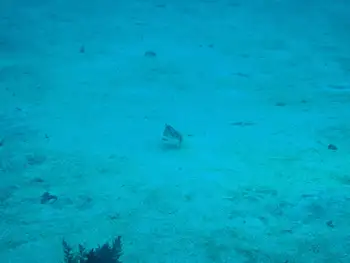Taxonomy
Animalia
Chordata
Actinopterygii
Lophiiformes O. Ogcocephalus darwini
Red Lipped BatfishDarwin's Batfish Tuft-shaped
The anglerfish are fish of the teleost order Lophiiformes. They are bony fish named for their characteristic mode of predation, in which a modified luminescent fin ray (the esca or illicium) acts as a lure for other fish. The luminescence comes from symbiotic bacteria, which are thought to be acquired from seawater, that dwell in and around the esca.
Some anglerfish are notable for extreme sexual dimorphism and sexual symbiosis of the small male with the much larger female, seen in the suborder Ceratiidae, the deep sea anglerfish. In these species, males may be several orders of magnitude smaller than females. Anglerfish occur worldwide. Some are pelagic (dwelling away from the sea floor), while others are benthic (dwelling close to the sea floor). Some live in the deep sea (such as the Ceratiidae), while others on the continental shelf, such as the frogfishes and the Lophiidae (monkfish or goosefish). Pelagic forms are most often laterally compressed, whereas the benthic forms are often extremely dorsoventrally compressed (depressed), often with large upward-pointing mouths.
Lophiiformes. Retrieved November, 05 2021, from en.wikipedia.org/wiki/Anglerfish.
Ogcocephalidae is a family of anglerfish specifically adapted for a benthic lifestyle of crawling about on the seafloor. Ogcocephalid anglerfish are sometimes referred to as batfishes, deep-sea batfishes, handfishes, and seabats. They are found in tropical and subtropical oceans worldwide. They are mostly found at depths between 200 and 3,000 m (660 and 9,840 ft), but have been recorded as deep as 4,000 m (13,000 ft). A few species live in much shallower coastal waters and, exceptionally, may enter river estuaries. They are dorsoventrally compressed fishes similar in appearance to rays, with a large circular or triangular head, which in Coelophrys is box-shaped, and a small tail. The largest members of the family are approximately 50 cm (20 in) in standard length. The illicium (a modified dorsal fin ray on the front of the head supporting the esca, a bulbous lure) may be retracted into an illicial cavity above the mouth. The esca is not luminous, as in most other groups of anglerfishes, but secretes a fluid thought to act as a chemical lure, attracting prey. Analysis of their stomach contents indicates that batfishes feed on fish, crustaceans, and polychaete worms. This family grouping contains approximately ten genera and 75 known species found in almost all tropical seas around the world.
Ogcocephalidae. Retrieved November, 05 2021, from en.wikipedia.org/wiki/Ogcocephalidae.
The red-lipped batfish or Galapagos batfish (Ogcocephalus darwini) is a fish of unusual morphology found around the Galapagos Islands and off Peru at depths of 3 to 76 m (10 to 249 ft). Red-lipped batfish are closely related to rosy-lipped batfish (Ogcocephalus porrectus), which are found near Cocos Island off the Pacific coast of Costa Rica. This fish is mainly known for its bright red lips. Batfish are not good swimmers; they use their highly adapted pectoral, pelvic and anal fins to "walk" on the ocean floor. When the batfish reaches maturity, its dorsal fin becomes a single spine-like projection (thought to function primarily as a lure for prey).
Ogcocephalus darwini. Retrieved November, 05 2021, from en.wikipedia.org/wiki/Red-lipped_batfish.
